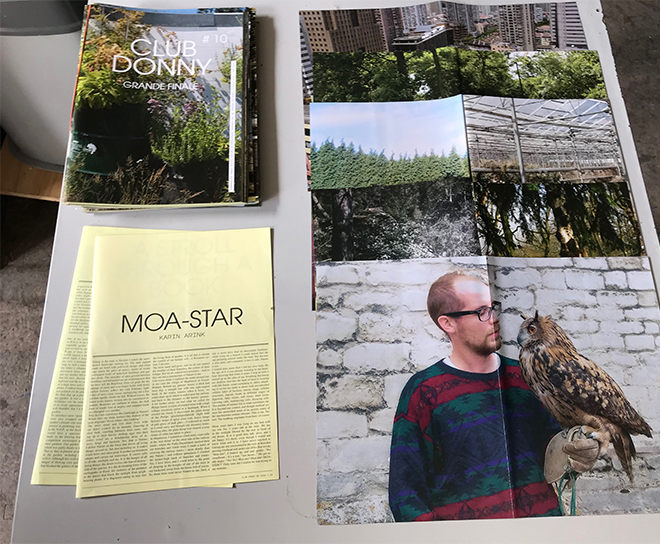MoastarTxt
A-ZMOA-STAR!
Sitting in the train to Bremen I watch the snow-dusted landscape rushing by. The dark asphalt roads are lined with yellowish sludge, and white caps adorn the piles of stones, stacks of wood, corrugated roofs of industrial buildings and garden sheds. The stretches of open ground between buildings and infrastructure are widening now that we have left the Randstad. Grey ice grips the dry stumps of reeds and ever-larger fields with thinly etched furrows reflect the cold February light. Lines of trees come closer, multiplying into a forest that rapidly climbs the hill. Without leaves, the forest looks barren, broken into its constituent elements. Branches are outlined in white, the dark lines of trunks lean at angles; one snapped trunk lies slumped over another.
Why do I not experience this landscape as Nature? Where does my deep, instinct-like distrust of the term originate? From where this loathing?
The trees stand and live their lives without direct control by us humans. Gnawing at their bark, crawling between their roots, curling up in their leaves, drilling eggs into their rotten wood are a bewildering array of insects, fungi and bacteria. Yes, that is Nature.
I define Nature as the force that drives all living things: around us, but also including us. It makes winds blow and rains pour. It pushes up mountain ranges and carves out waterways. It causes cells to divide, multiply and die. It is the hunger of all living things, the desire to live, the fear of destruction of the species. It is the devastating force of the earthquake or flood, the violence of the predator or the leaves that block
the sunlight from neighbouring plants. It is the insect eating its way into the living flesh of another. It is all that is outside the control of our human will… a Romantic notion, I am sure.
The trees stand and grow, and we do not control the number of their branches, the colour of their foliage. But we do control their presence… And so they are but a simulacrum of Nature to me.
Like every child, I explored the realm around me, in my case the village of Maarheeze in Noord-Brabant. Behind my parents’ house, a ditch had been dug: a straight line with one right-angled bend. In the scarce winters when it froze, we could skate up to where it ended near the railway, and back to the entrance to the horses’ pasture. A bit further away, we had what we called the Philips forest: a copse of planted trees with a high voltage electricity pylon as a landmark. When I crossed the forest, I discovered the glass dump of the Philips
‘gloeilampenfabriek’ (light bulb factory): heaps of spiny glass rods, heavy lumps of pale glass, of dark glass… I collected as much as I could carry and brought my treasures home. Not long after, the glass dump was cleared; a cosy clutter of villas has taken its place.
In Maarheeze, I learned to climb trees, especially in the ’tree dump’ on the other side of the railway tracks, where the Parks Department stashed their cut branches and whole trees. I made a habit of crossing the railway tracks – more deadly than any Nature – and without queasiness I climbed the meters-high stack of branches and trunks. Yes, I love trees, and I could relax to the point of sleeping in the boughs of one of the trees in our backyard, away from the house full of voices.
So, these trees were never Nature to me. Sure, a tree is more alive than its descendant furniture; while lying on a branch I could almost feel the sap pumping around under the bark. But the tree is also static and contained. A tree is safe, Nature is not.
I trusted trees more than I did my own body. By the age of 8, I was already listening to my heartbeat: knowing that when it stops, I stop as well. I tensed up at the idea of my breathing becoming too shallow. Just like the bark of trees is teeming with life forms, some sustaining it, others attacking it, so too my body is abuzz with uncontrolled entities: kilos of bacteria, mucus, fungi, cellular structures, liquids, foods in different stages of digestion, fatty tissue, soft tissue, hard tissue. Growing cells, multiplying cells, decaying cells. This jumble of natural life is what constitutes me. It is beyond our control, and though medical science has unravelled some of its secrets, many of the mechanisms remain obscure. This is me. Nature. The loathing originates from here, of course.
Many years later, I was lying on my bed with my son Jin, 3 years old at the time. We lay in the sunlight filtered by the tree in front of our house. It is a good tree: tall, alive, and I am happy it’s there, even though I would not know what sort it is. I have never touched it.
Gazing up, my son pointed to the web of branches moving overhead and spoke one of his first words: “Moa-star”.
I looked up, and said gently: “No, sweetheart… It’s a tree, “een boom…” He got really angry: “No! No! Moa-star! Moa-star! MOA-STAR!!”
Only later did I realize he was trying to say “monster”…
 this text [published](/Cvpubl) in 'Club Donny'
here in the studio of one of the editors/founders of this magazine on nature's role in relation to culture,m Frank Bruggeman (who has his studio next to mine at [Foundation B.a.d](/Foundationbad)
this text [published](/Cvpubl) in 'Club Donny'
here in the studio of one of the editors/founders of this magazine on nature's role in relation to culture,m Frank Bruggeman (who has his studio next to mine at [Foundation B.a.d](/Foundationbad)